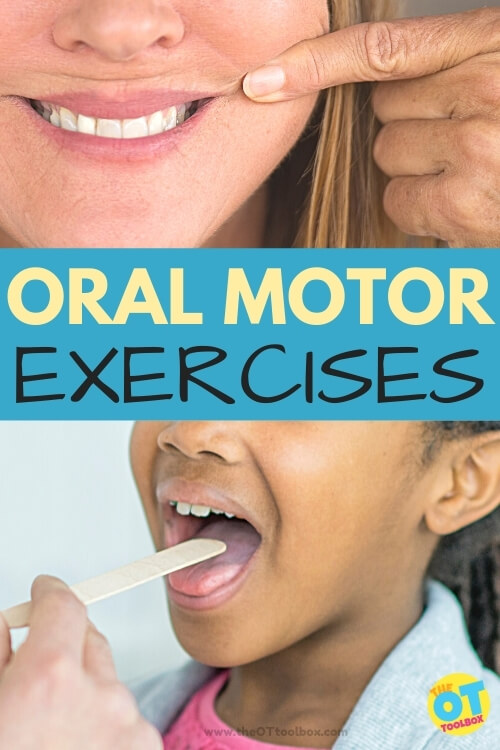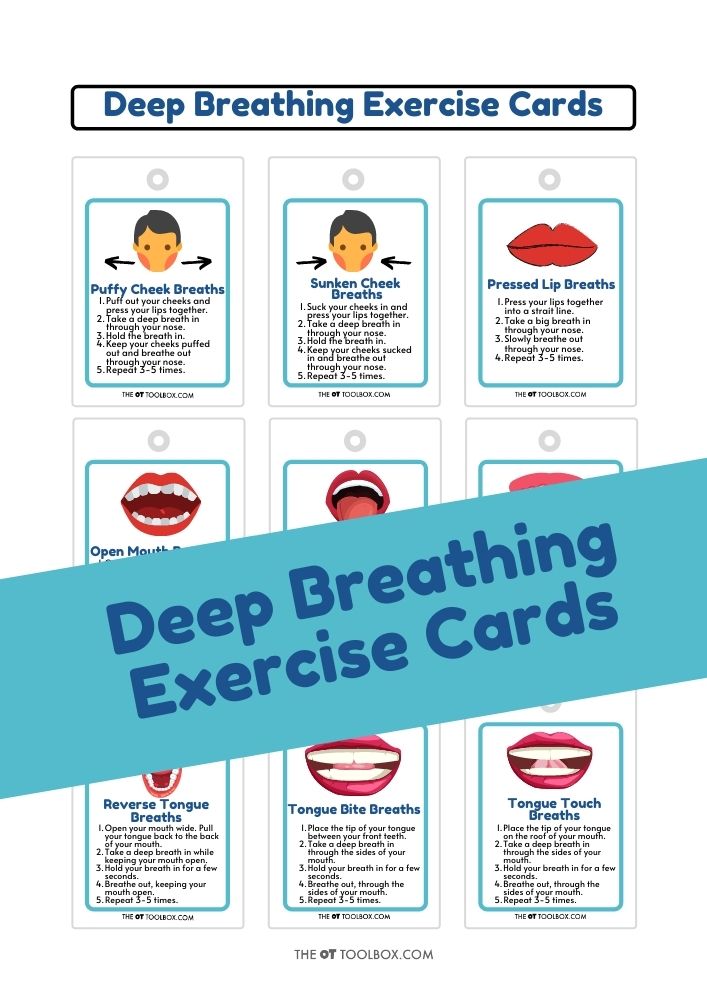There are many reasons to incorporate oral motor exercises into your therapy plan. Here, we are covering the reasoning behind several oral motor exercises and strategies to work on mobility and functioning in the mouth, tongue, lips, and jaw.

Why Oral motor Exercises?
When we talk about oral motor exercises, it’s important to know why we are considering specific exercises. When it comes to oral motor exercises, we are striving to improve the functioning of the mouth, jaw, lips, cheeks, and tongue so that the child can demonstrate coordination needed for sound production and articulation. Other issues can arise in manipulation (chewing, movement of foods and liquids, tolerance of various textures, and swallowing food and liquids).
When it comes to feeding issues, there can be a question of whether the feeding problems are a result of sensory processing challenges and/or oral motor considerations. Check out this resource for more information on pediatric feeding and oral motor issues or sensory issues that impact feeding abilities.
Kids who struggle with feeding may be impacted by oral awareness and oral discrimination. These skills enable us to both be aware of the motions of the muscles and joints of the mouth to enable positioning for oral sound creation as well as movements to control and mobilize the chewing and manipulation of foods and drinks of various textures.
Oral discrimination is essential for safety, efficiency, and function when eating. When oral discrimination is a challenge, children can have resulting food aversions, be unaware of food in their mouth, or not be able to tolerate certain types of foods because of food texture issues, tastes, or temperatures. They may have difficulty with managing various textures and end up with messy eating during meals. Oral discrimination also effects skills like speech and tooth brushing.
Start here by reading more about the development of oral motor skills. Typical development of oral motor skills is an important consideration when it comes to self-feeding and movements of the mouth, tongue, and lips in tolerating new foods or textures in feeding.
Specific reasons for incorporating oral motor exercises into a therapy program may include issues with the following movements:
- Jaw Thrust
- Exaggerated Jaw Movements
- Jaw Instability
- Jaw Clenching
- Tooth Grinding
- Stability Bite
- Tonic Bite
- Jaw Retraction
- Tongue Retraction
- Tongue Protrusion
- Tongue Thrust
The oral motor exercises listed below can offer additional opportunities for strength and coordination of oral motor skills, as well as heavy work proprioception through the mouth as calming input to organize the body.
Oral Motor Exercises
These activities are not the only ones that can be done to address oral discrimination issues. Additionally, it’s important to know that therapists understand that oral discrimination is just one piece of the feeding puzzle. Considerations such as tone, sensory processing, and oral-sensory exploration as well as many other components make up feeding.
Tips for Oral Motor Exercises
- These specific oral motor exercises can be selected based on the specific needs of the child. Each exercise many not work for all individuals. And, the exercises should be modified as needed to grade up or down (make them easier or harder) based on the needs of the individual.
- For each exercise listed below, add a repetition to complete the task. Add in a specific number of repetitions.
- Add the number of days these exercises should be completed each week.
- Incorporate function whenever possible. Working on feeding? Add real foods of interest. Use utensils or cups when possible. Incorporate the occupation of play to make the exercises motivating and fun.
- Consult with a pediatric occupational therapist!
Oral Motor Exercise Ideas
Remember that not all of these exercises are needed for every child’s specific needs. Pick and choose the exercises that meet the needs of the child you are working with.
- Bring their hands and fingers to his or her mouth and lips.
- Play tongue Simon Says with a mirror. We have many oral motor Simon Says commands that can be printed off to target specific motor skills with the lips, jaw, cheeks, and tongue.
- Play the “hokey pokey” with your tongue and cheeks.
- Try messy play with food.
- Encourage tolerance of a spoon or other feeding utensil in different parts of the mouth.
- Open and close your mouth.
- Move your tongue from side to side.
- Press your lips together and then smack your lips apart.
- Explore different types of utensil textures (plastic, metal, plastic covered, etc.)
- Hold and play with a toothbrush, bringing the brush to their mouth and face.
- Encourage mirror play, identifying parts of the mouth.
- Add rhythmical, whole- body play with therapy balls, uneven surfaces such as trampolines or crash pads to improve proprioceptive input. (Great for core strengthening and stability needed for feeding, teeth brushing, etc.)
- Explore mouth play with teething toys and tools.
- Explore use of teething toys and tools in different positioning (prone, supine, side lying, etc.)
- Use rhythmical music along with tapping the cheeks or lips.
- Offer frozen fruit on a tongue depressor. Try this recipe for frozen fruit skewers.
- Chew a straw.
- Pucker your lips in a pretend kiss.
- Blow a party noise maker.
- Blow a kazoo.
- Use a straw to pick up squares of paper and drop them into a bowl.
- Make fish lips.
- Apply Chapstick (scented or unscented) and press your lips together as you move your lips from side to side.
- Puff up your cheeks.
- Smack your lips.
- Whisper the sounds the letters of the alphabet make from A-Z. Notice how your mouth moves. Or, spell out your name or other words by whispering the sounds the letters make.
- Blow bubbles
- Blow through a straw to move a cotton ball or small craft pom pom along a line. Can you move it through a maze?
- Freeze water to a popsicle stick and lick or suck until the ice melts.
- Try making these Shirley Temple popsicles. They are a tasty oral motor exercise tool.
- Pour water into an ice cube tray. Add popsicle sticks to create a cube pop. Lick and suck until the ice melts.
- Scoop peanut butter onto a spoon. Lick it off with the tip of your tongue.
- Point your tongue to the end of your nose. Hold it there as long as you can.
- Point your tongue to your chin. Hold it there as long as you can.
- Push your tongue into your right cheek. Hold it there and then press the end of your tongue into your left cheek.
- Count your teeth using your tongue. Touch each tooth with the tip of your tongue.
- Chew gum. Can you blow a bubble?
- Deep breathing mouth exercises. Use these printable deep breathing cards.
Themed Oral Motor Exercises
You may want to check out these themed oral motor exercises for development of motor skills in various points throughout the year. These themed exercise can be added to weekly therapy themes to increase motivation and carry through. Here are several themed oral motor exercises for kids:
- Summer Oral Motor Activities
- Animal Oral Motor Activities
- Boat Oral Motor Activity
- Bunny Oral Motor Activity
Want printable oral motor exercises? Grab the Deep Breathing Exercise Cards. The pack of deep breathing cards includes oral motor exercises for heavy proprioceptive input through the mouth, tongue, and lips, and oral motor activities using different themes, totaling 113 different exercises.
The Oral Motor Exercises can be done anytime, using just the mouth. These strategies offer exceptional proprioceptive input through the lips, tongue, and cheeks, making a calming heavy work activity that can be used in sensory diets to help children achieve a calm and ready state of regulation.
Click here to get your copy of the Deep Breathing Exercise Cards.

Colleen Beck, OTR/L has been an occupational therapist since 2000, working in school-based, hand therapy, outpatient peds, EI, and SNF. Colleen created The OT Toolbox to inspire therapists, teachers, and parents with easy and fun tools to help children thrive. Read her story about going from an OT making $3/hour (after paying for kids’ childcare) to a full-time OT resource creator for millions of readers. Want to collaborate? Send an email to contact@theottoolbox.com.







